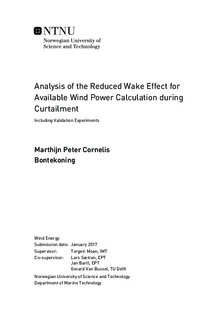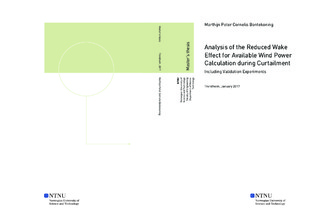| dc.description.abstract | With increasing wind power capacity, the impact of wind power on power system operation increases. For a mature integration of large amounts of wind power, controlling wind farm output by temporary curtailment becomes increasingly relevant. Wind farm curtailment provides valuable technical and economic opportunities for balancing the power system. However, quantifying the exact amount of curtailed wind power at the wind farm level is not trivial. This is because curtailment induces a reduction of the wake effects, complicating the determination of the available power in the wind. Understanding the reduced wake effect is important to improve the technical reliability and business case of wind power curtailment, especially for very large offshore wind farms.
The purpose of this research is to present and validate an algorithm to determine the available power of a wind farm during curtailment. Current best practices in available power estimation is to sum the individual turbine available power signals. This leads to an overestimation, as the reduced wake effect is not accounted for. In the algorithm developed in this thesis, existing wake models play a key role in quantifying the reduced wake effect. These wake models have been validated first for wind turbine operation without curtailment and then for operation during curtailment. For the latter, curtailment experiments were prepared and executed on the existing nearshore wind farm Westermeerwind, consisting of 48 wind turbines in commercial operation. Based on that, the developed algorithm has been validated for wind turbines in a straight row and for sub-rated wind speeds.
In the experiments, the first turbine in the row was curtailed and the reduced wake effect was clearly observed at the second turbine. The reduced wake effect led to a power increase of the second turbine of 45% to 80% of the curtailed power of the first turbine. However, it also led to a power decrease for the third turbine in a range of 5% to 40% of the curtailed power. No noticeable structural changes in power production were observed from the fourth turbine onward. The algorithm was shown to perform well in calculating the available power at the second turbine, with the Jensen wake model delivering the lowest error. For the third turbine, the algorithm did not perform well, due to relatively large errors of the wake models for the third turbine. The Larsen wake model resulted in the lowest error considering the available power of the whole row of turbines.
Overall, it is concluded that the algorithm proposed and validated in this thesis delivers a significantly improved estimation of the available power during curtailment. It is recommended to continue study of the proposed algorithm by testing the performance of other wake models, performing more (types of) curtailment experiments and obtaining higher quality wind data. | |

